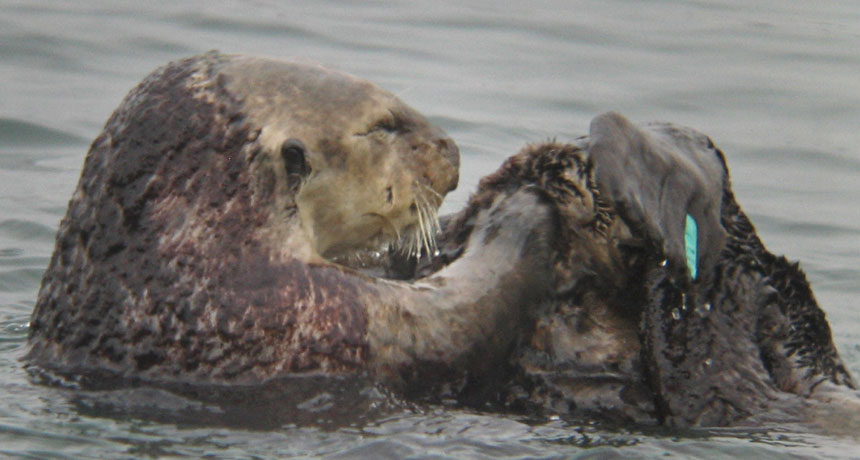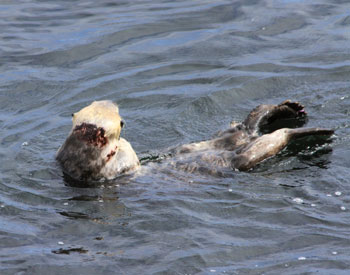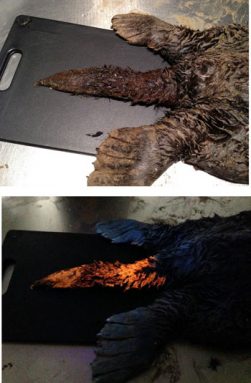Some otters wear red algae
Red-colored growths are likely an invasive species

This female sea otter lives in Morro Bay, Calif. She has red algae growing on her back. The algae is likely an invasive species, but it doesn’t seem to harm her or other otters.
Brian Hatfield
In the fall of 2010, Gena Bentall looked to sea through a telescope that was on the edge of a cliff along the California coast. It was not far from the Monterey Bay Aquarium, where she worked on sea otter research and conservation. The aquarium aims to protect otters, a species threatened with extinction. On this fall day, she and her colleagues made an unusual observation. A large male otter, nicknamed Repu, seemed to be wearing a scraggly red coat on his back. The red stuff was a type of microscopic algae.
Otters “are constantly scrubbing, licking and attending to their fur coat in order to keep it in good condition,” says Bentall. She thought it would be too difficult for algae to stay attached to an otter’s fur as it swam quickly and cleaned itself. After all, this red alga typically grows on rocks or slow-moving animals, such as snails.

Bentall was not the first to witness this. Researchers had spotted other otters with reddened fur as early as the 1980s. And over the years, the number of such otters seemed to grow. Bentall and her colleagues now get reports about red-coated otters. People often mistake the red for blood or crude oil. “They don’t realize it’s algae,” she says.
Recently, Bentall decided to take a closer look. She recruited specialists who don’t often work together: biologists like herself who study otters in the wild, pathologists who study diseases that kill otters and scientists who study algae. The group identified the red alga and figured out how it grows on otters. The good news is there is no evidence it harms the animals.
Bentall’s team reported its new findings November 27 in Marine Mammal Science.
Friend or foe?
Bentall’s team reviewed more than 1,000 reports describing the condition of otters — both alive and dead — from 2000 through 2014. Less than one percent mentioned algae.
However, Bentall notes, the people writing these reports most likely were not looking for algae. When an otter has dark fur, dark red algae can be difficult to see. But she and her colleagues realized that under an ultraviolet light — also known as a black light — the red algae glows bright orange!
The species is called Acrochaetium secundatum (AH-kro-KAYT-ee-um See-kum-DAH-tum). It usually lives in the North Atlantic — not the Pacific Ocean. Most likely, Bentall now suspects, this alga stowed away on boats traveling between the oceans. Eventually it wound up in the Pacific. “We have a strong suspicion that this is an invasion of an Atlantic species,” she says.
Otters with red algae on their coats seem to be faring just as well as those without any. This surprised Bentall. These critters rely on their thick fur to work like an insulating wetsuit. It keeps them warm in the cold seawater. Anything that interferes with that fur could let cold water reach the skin. Then, an otter might lose much of its body heat and die.

However, the new research shows, the red alga only grows at the very tip of the longest hairs. There, it may easily reach nutrients in the seawater. The alga does not grow on the otter’s deep coat of underfur. That’s why Repu and other algae-covered otters can stay warm.
That algae are growing on otters at all is unusual, says Dave Jessup. A retired veterinarian, he used to direct the Marine Wildlife Veterinary Care and Research Center in Santa Cruz, Calif. Run by the California Department of Fish and Wildlife, or CDFU, it supports sea otter research. He was not involved in Bentall’s study. But he, too, suspects the red alga is likely an invasive species that only recently began hanging onto otters.
Jessup notes that the algae don’t have any reason to harm their host. “They are just looking for a place to live,” he says. And an otter’s fur is a pretty good spot. As long as the alga can hold on as the otter grooms, it will gain protection from its enemies. Snails like to eat algae, but they tend to stay away from otters. Best of all, the algae gain access to the nitrogen present in an otter’s urine and feces. Nitrogen helps fuel the growth of algae. For that reason, the algae commonly attach to fur along an otter’s tail. That puts them closest to those nutrient-rich wastes.
An algae power-up

In 2010, Melissa Miller of the CDFW in Santa Cruz led a team of scientists in studying blooms of blue-green algae. These algae released poisonous toxins. If an otter dined on clams, mussels or oysters that had eaten these algae, then the otter could have sickened or died. Tainted shellfish sicken other wildlife and people, too.
Indeed, Miller says, poisonous algae blooms are a big problem: “Just last summer, and even now along the Pacific coast, we’ve had some of the most significant toxic marine-algae blooms we’ve ever seen.”
Miller has worked with Bentall to study the red alga. Even though it is not poisonous, its presence still concerns these scientists. If the algae create drag on the fur, then otters may need to spend more of their precious energy swimming or more time grooming, Bentall worries. Many otters face other serious survival risks as well. These include shark attacks, harmful parasites, pollution and, of course, algal poisons. Bentall now runs a California-based program called Sea Otter Savvy. It works to keep kayakers and other boaters from disturbing the animals.
The more scientists learn about all the dangers facing sea otters, the better they will be able to protect and care for them.
Power Words
(for more about Power Words, click here)
alga (plural: algae) A single-celled organism, once considered a plant (it isn’t). As an aquatic organism, it grows in water. Like green plants, it depends on sunlight to make its food.
biology The study of living things. The scientists who study them are known as biologists.
black light A light that emits ultraviolet light. It helps make certain substances fluoresce.
bloom (in microbiology) The rapid and largely uncontrolled growth of a species, such as algae in waterways enriched with nutrients.
conservation The act of preserving or protecting something. The focus of this work can range from art objects to endangered species and other aspects of the natural environment.
ecology A branch of biology that deals with the relations of organisms to one another and to their physical surroundings. A scientist who works in this field is called an ecologist.
endangered An adjective used to describe species at risk of going extinct.
extinction The permanent loss of a species, family or larger group of organisms.
drag A slowing force exerted by air or other fluid surrounding a moving object.
feces A body’s solid waste, made up of undigested food, bacteria and water. The feces of larger animals are sometimes also called dung.
fertilizer Nitrogen and other plant nutrients added to soil, water or foliage to boost crop growth or to replenish nutrients that removed earlier by plant roots or leaves.
invasive species (also known as aliens) A species that is found living, and often thriving, in an ecosystem other than the one in which it evolved. Some invasive species were deliberately introduced to an environment, such as a prized flower, tree or shrub. Some entered an environment unintentionally, such as a fungus whose spores traveled between continents on the winds. Still others may have escaped from a controlled environment, such as an aquarium or laboratory, and begun growing in the wild. What all of these so-called invasives have in common is that their populations are becoming established in a new environment, often in the absence of natural factors that would control their spread. Invasive species can be plants, animals or disease-causing pathogens. Many have the potential to cause harm to wildlife, people or to a region’s economy.
microorganism A living thing that is too small to see with the unaided eye, including bacteria, some fungi and many other organisms such as amoebas. Most consist of a single cell.
microscopic An adjective for things too small to be seen by the unaided eye. It takes a microscope to view such tiny objects, such as bacteria or other one-celled organisms.
nitrogen A colorless, odorless and nonreactive gaseous element that forms about 78 percent of Earth’s atmosphere. Its scientific symbol is N. Nitrogen is released in the form of nitrogen oxides as fossil fuels burn.
organism Any living thing, from elephants and plants to bacteria and other types of single-celled life.
pathology The study of diseases and/or conditions that lead to death. People who work in this field are called pathologists. They look at what causes a disease, how symptoms develop and may examine all stages of an illness.
pollutant A substance that taints something — such as the air, water, our bodies or products. Some pollutants are chemicals, such as pesticides. Others may be radiation, including excess heat or light. Even weeds and other invasive species can be considered a type of biological pollution.
seawater The salty water found in oceans.
species A group of similar organisms capable of producing offspring that can survive and reproduce.
telescope Usually a light-collecting instrument that makes distant objects appear nearer through the use of lenses or a combination of curved mirrors and lenses. Some, however, collect radio emissions (energy from a different portion of the electromagnetic spectrum) through a network of antennas.
threatened (in conservation biology) A designation given to species that are at high risk of going extinct. These species are not as imperiled however, as those considered “endangered.”
toxin A poison produced by living organisms, such as germs, bees, spiders, poison ivy and snakes.
ultraviolet A portion of the light spectrum that is close to violet but invisible to the human eye.
wetsuit An outer rubber or rubber-like suit worn over the body (including arms and legs) when swimming in cold water. It help preserve body heat and limit other risks to the skin of divers.







